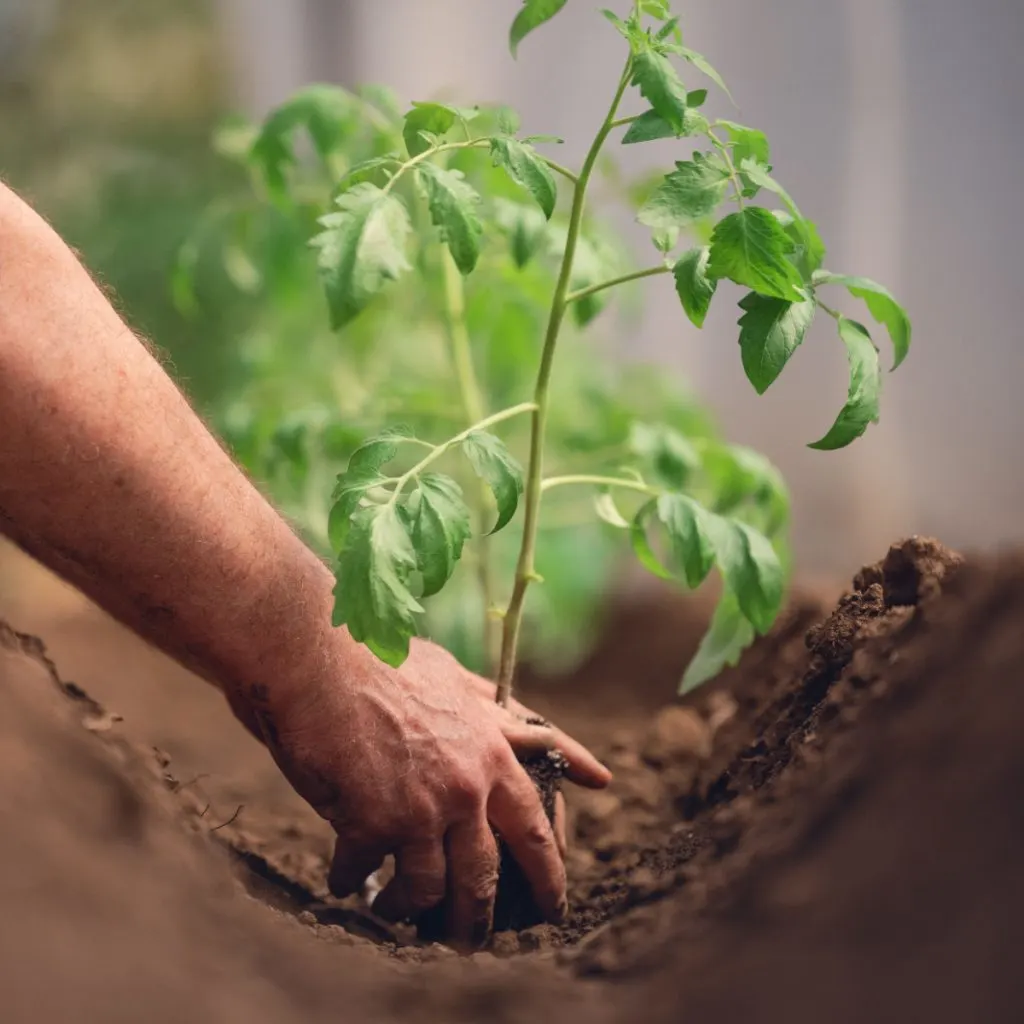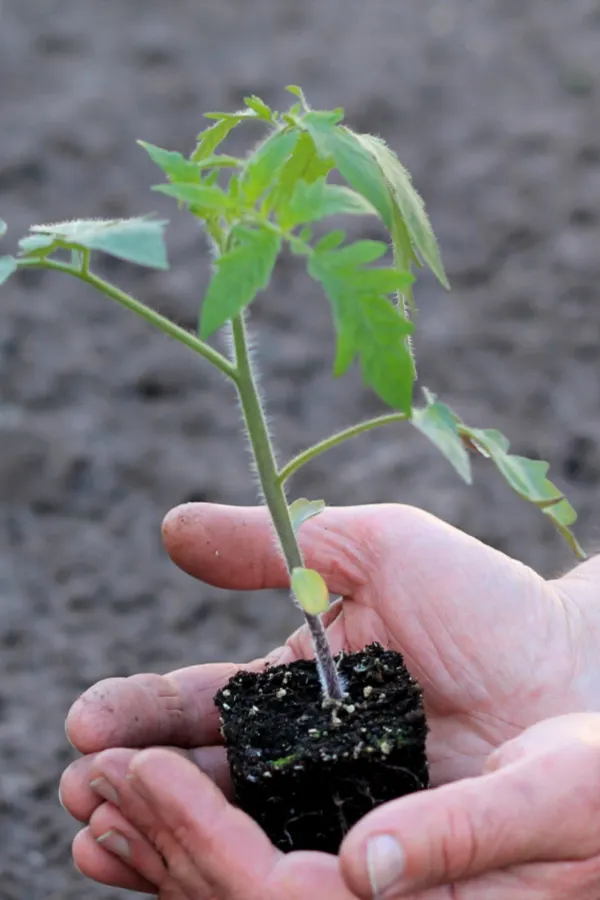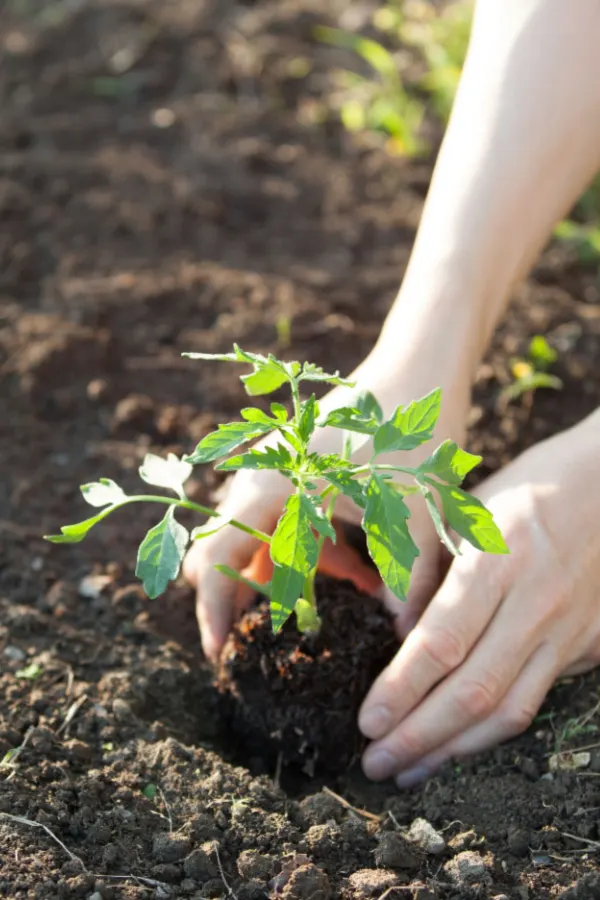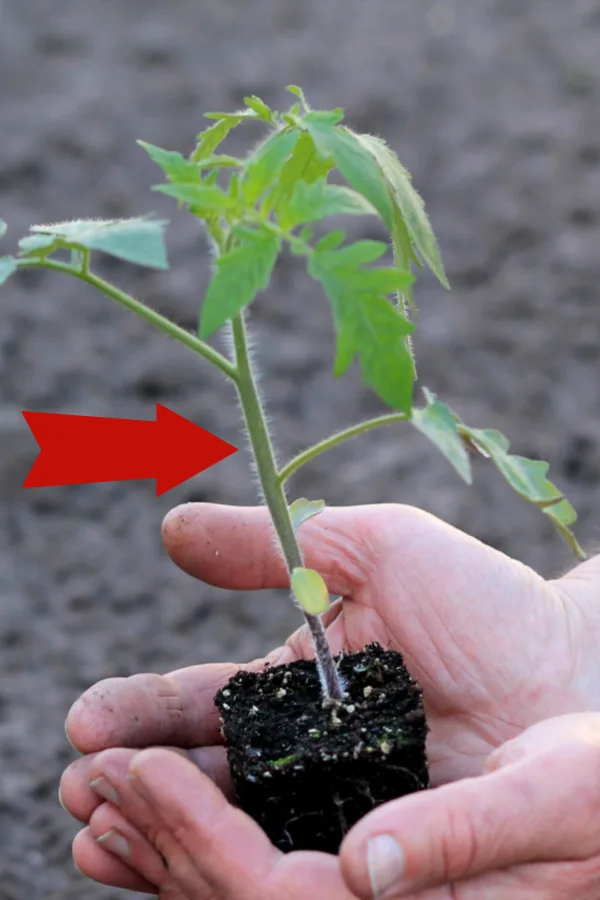When it comes to how deep to plant your tomato plants – most gardeners are quite surprised to find out how far down their transplants should be placed into the ground on planting day – and just how much difference it can make in how well they perform!
One of the most important days of a tomato plant’s life – if not the most important day of its life – is the day it goes into the ground. Planting day sets the stage in so many important ways for how a tomato plant will grow and produce.
To mature into a healthy, productive plant, a tomato plant needs to get plenty of nutrients and water. That’s exactly why on planting day it’s so vital to fill your planting hole full of powerful food – and why it’s also critical to water it in as well. Just like it’s also important to mulch and support your plants on planting day too.

But as important as those chores are on planting day – there is one more that is even bigger – and that is to plant your tomato plants deep in the ground.
Why? Because as you will see below, planting deep gives your plants the absolute best chance to soak in everything they need – all while protecting them from many of the issues that can injure, harm or even kill of shallow planted tomatoes. And you might just be surprised how far down the root ball needs to go!
How Deep To Plant Tomato Plants
Why Planting Deep Matters
We will get to how deep to plant your tomatoes in just a moment, along with a few tips of what to put in your planting hole to get them off to a fast start – but let’s first cover all of the reasons why planting so far down in the soil is so important.
At the beginning of the article, we covered how crucial it is for a tomato plant to get consistent water and nutrients. A tomato plants absorbs most of the moisture and nutrients it needs through its root system. It can absorb some from it’s foliage, but the largest majority are taken in through its roots.
Because of that, the bigger a tomato plant’s root system can be, the better. Naturally, the more roots that grow in the soil, the more food and water a plant will be able to take in. And not just nutrients from the soil, but also fertilizer and other amendments you might give your plants throughout the season.

So how do you get more roots? The answer is simple – by planting your tomato plants deep! In fact, as it turns out, there are actually two great reasons planting far down in the soil helps to create more roots for your tomatoes.
How Planting Deep Creates More Roots – How Deep To Plant Tomato Plants
The first way planting deep helps is fairly obvious. By simply placing the main root ball of your transplant deeper, it has a lot more room to expand.
Unfortunately, when you plant in a shallow hole, the roots tend to stay near the surface. Not only because the unworked soil underneath is hard for them to expand down into, but even more because they are close to where moisture arrives when it rains or you water.
That may sound like a good thing for tomato plants, but it’s not. Not in the least. Shallow roots at the surface may get water quickly when it rains, but they also dry out quickly in the hot sun. Even worse, without strong roots down deep, they also topple over easily with storms or a heavy fruit load.

The second reason planting deep helps develop more roots has to do with the main stem of a tomato plant. If you look at the leading stem of a young tomato transplant, you will see hundreds of tiny white hairs.
Those “hairs” are actually mini-roots. If the hairs stay above soil, they simply stay as is, tiny white hairs. But when they are placed in the soil and covered, they grow into roots – and a lot of them. And the more roots your plant has, the more energy and moisture it can absorb all summer long!
How Deep To Plant Your Tomatoes
So how deep should you plant? Believe it or not, you should be planting 2/3rds of your entire tomato transplant in the soil on planting day.
A typical tomato transplant measures somewhere between 12 and 18 inches from the bottom of the root ball to the top of the plant. That means that when planting, 8 to 12 inches of the plant should go in the ground. And don’t worry about any leaves you might bury, it won’t harm the plant in the least!

It may sound like a lot, but it’s actually the perfect way to set your plant up for success. Roots will quickly establish along the stem and deep in the hole. Down deep in the soil, moisture will not dry out nearly as quick as it does on the surface. And all of those extensive roots make it easy for the plant to soak up both water and energy to power the plant.
A Few Planting Day Tips! – How Deep To Plant Tomato Plants
In addition to planting deep, it’s important to fill that planting hole with big power. One of the biggest things you can add to do just that are worm castings.
Worm castings have the perfect balance of nutrients to power young tomato plants. Even more, they help to absorb and hold moisture at nearly 10 times their weight! Affiliate Link: 100% Pure Organic Worm Castings Fertilizer, 15-Pounds
As you plant, add 1/2 to 3/4 cup of castings into the bottom of every planting hole. In addition, adding ground egg shells, compost and coffee grounds can help fill your planting hole with even power.

And speaking of that planting hole, always loosen the soil a few inches below from the bottom. This will allow the roots of your plant more loose soil to expand even deeper. See: 4 Must Add Ingredients To Put In Every Tomato Planting Hole!
Finally, don’t forget to put in your tomato supports the day you plant. This not only allows you to support tender young plants right from the start, but also prevents damaging growing roots if you wait until a few weeks later to put them in.
Here is to planting your tomatoes deep this year – and to having your best tomato harvest ever!
This Is My Garden
Follow Our Facebook Page For Great Gardening Tips And Advice! This Is My Garden Facebook Page
This Is My Garden is a garden website created by gardeners, for gardeners. Jim and Mary Competti have been writing gardening, DIY and recipe articles and books and speaking for over 15 years from their 46 acre Ohio farm. They publish three articles every week, 52 weeks a year. Sign up today to follow via email, or follow along!
